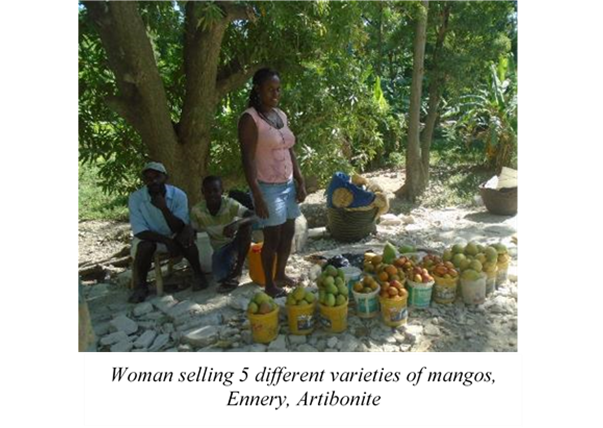- While Haiti tree crops coffee and cacao have gone from being world leaders to close to no exports at all, mangos have gone the other direction, first becoming a Haiti export crop only in 1954 and then rising to the 2015 record season of 2.48 million boxes (4.5 kg/box).
- After Vetiver—contrary to claims, a veritable erosion nightmare (see blog on “Vetiver Travesty”)– Mangos are Haiti’s most important export crop in terms of value (US$12 million), volumes (11,150 Metric Tons).
- In 1990 Haiti was the second largest importer of mangos to the USA.
- Since that time Haiti has fallen to 6th place as a source of mangos for the US market. But the fall is not because of a deterioration of the industry—which has held steady since 1990—but because of a massive rise in US consumption of mangos, a demand met mostly by Mexico, Peru, Ecuador, Brazil, and Guatemala. Although 2015 was a record high season, Haiti exported only 5% more mangos in 2015 than in 2006, or even year 2000 or year 1990.
- By far the most exported mango in Haiti (more than 95% of all Haiti mango exports) is the Madame Francique mango, also called the Madanm Francis, Francine, Francique, or simply Fransik. The reason for its role as the only exported Haitian mangos is because of the threat of the Mediterranean fruit fly and USDA requirement that mangos be dunked in hot water for 60 to 90 minutes, killing any fly larvae. The Francique is the only Haitian Mango that resists the heat.
- But the Francique is also a large fleshy, low fiber and tasty mango, factors that help make it the most expensive Mango in the United States, selling wholesale for as much as 3 times that of other imported mangos. A single mango sells for as much as US$4.00 in US specialty supermarkets.
- Yet, Francique mangos comprise only 20% of mangos in Haiti; and only 20% of these are exported: meaning that only 4% of Haiti’s mangos are exported.
- The Francique mango is best described not as a planted, cultivated and cared for perennial, but as a prolific and appreciated weed, sprouting up from discarded seeds in moist ravines hillsides and slopes.
- The Francique mango industry in Haiti is one of the few if not the only fruit export industries in the world where micro producers– with an average of three trees per farmer–produce 90% of the crop.
- An estimated 200,000 Haitian households own at least one mango tree; about 40,000 of them have at least one Francique mango tree.
- Export of mangos from Haiti to the US market is controlled by a cartel of eight individuals and their families, something made possible through a pact with the Haitian Ministry of Agriculture and the USDA.
- The proportion of the retail value of an exported Francique that goes to the small producers is far below the average retail value that goes to producers for other mangos and may be the lowest in the world. In 2015 it was divvied up as followed,
-
- Haiti Small producers: 3-5 US cents per mango
- Haiti based Export intermediaries: 7 -12 US cents per mango
- Haiti based Export packing houses: 80 US cents per mango
(for references and more data see here)








